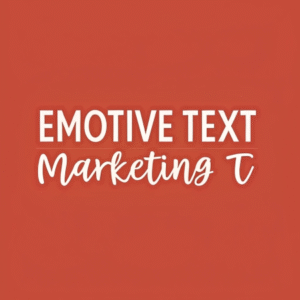Emotive text marketing uses feelings to connect with customers. It’s not just about selling things. It’s about making people feel something when they read your messages. Think about a time you felt happy, excited, or even a little sad after reading something. That’s the power of emotion. When businesses use this, their messages become super powerful. They stick in people’s minds. Customers remember these messages long after they read them. This makes them want to buy from you. It also makes them loyal to your brand. They feel a personal connection. This type of marketing goes beyond just facts. It speaks to the heart, not just the head. It builds stronger relationships. This is key for long-term success.
Why Feelings Matter in Text Messages
Messages that make you feel something are much better than plain ones. Imagine a text saying, “Sale on shoes.” Now imagine one saying, “Step into comfort and joy with our new shoe collection!” The second one makes you think about how the shoes will make you feel. It creates a picture in your mind. This is what emotive text marketing does. It uses words that trigger emotions. It helps customers see themselves using your product. They imagine the benefits, not just the features. This makes them more likely to act. They don’t just see a product; they see a solution to a need or a way to feel good. Therefore, emotion influences decisions strongly.
Tapping into Customer Emotions
Every person has different feelings. Marketers try to understand these feelings. They think about what makes their customers happy. What makes them feel safe? What problems do they want to solve? Once they know this, they can craft messages. These messages will speak directly to those emotions. For example, a travel company might use words about adventure. They might talk about freedom or excitement. A charity might use words about hope. They might focus on making a difference. This careful choice of words is important. It ensures the message resonates deeply. It makes customers feel understood.
Common Emotions Used
Many emotions work well in marketing. Joy makes people feel good. Messages about happiness can be very effective. Excitement creates anticipation. People get eager about new products or offers. Trust is vital for any business. Messages that build trust make customers feel secure. Security reassures them about their choices. Fear of missing out (FOMO) also drives action. People do not want to lose a good deal. Belonging makes people feel part of a community. They want to be included. Marketers mix and match these emotions. They use them to create powerful texts. They choose the best emotion for each campaign.
Crafting Your Emotive Messages
Creating these messages needs thought. First, know your audience well. What are their hopes and dreams? What are their worries? Second, choose your words carefully. Use strong, descriptive words. These words should paint a telemarketing data picture. They should make feelings come alive. Third, keep it short and sweet. Text messages are small. Every word counts. Make sure your message has a clear call to action. Tell customers what to do next. Do you want them to visit your website? Do you want them to buy now? Make it easy for them.
Examples of Emotive Language
Let’s look at some examples. Instead of “Buy our new coffee,” try “Awaken your senses with our rich, invigorating coffee.” The second one uses “awaken,” “senses,” “rich,” and “invigorating.” These words evoke feelings of warmth and energy. Instead of “Sign up for our newsletter,” try “Join our community and discover exclusive deals just for you!” This uses “community” and “exclusive,” creating a sense of belonging and specialness. These small changes make a big difference. They make the message more appealing. Moreover, they make it more memorable.
The Power of Storytelling
People love stories. Stories make messages more engaging. They help customers connect with your brand. You can tell a mini-story in a text. For example, “Imagine yourself on a beach, waves crashing, worries fading. Book your getaway today!” This short story paints a picture. It makes the customer feel the experience. Stories create a connection. They make the message feel more personal. Consequently, they are very effective for emotive marketing.
Making Your Emotive Texts SEO Friendly
Even though we’re talking about texts, SEO principles still matter. SEO stands for Search Engine Optimization. It’s about making your content easy to find. While search engines don’t crawl text messages directly, the principles of good content apply. Using relevant keywords indirectly helps your overall marketing. It ensures your message is clear. It also ensures it’s about what your customers care about. When customers search for something you offer, your website or social media should show up. Your emotive texts can guide them there.
Keywords and Content Harmony
Think about the words your customers use. What do they search for? These are your keywords. You won’t stuff keywords into texts. However, your overall messaging should align with them. If your texts talk about “organic skincare,” your website should too. This consistency helps build your brand’s authority. It makes it clear what you offer. When customers click a link from your text, they should find exactly what they expect. This harmony creates a seamless experience. Furthermore, it reinforces your brand’s message.
Clear Calls to Action (CTAs)
Every text needs a clear CTA. This tells the customer what to do. For emotive texts, the CTA can also be emotional. Instead of “Click here,” try “Unlock your inner glow!” or “Claim your adventure now!” These CTAs use feeling words. They make the action more appealing. A clear CTA guides the customer. It makes it easy for them to respond. As a result, this boosts your campaign’s effectiveness.

Personalization and Relevance
Personalization makes messages feel special. Use the customer’s name. Refer to their past purchases. This shows you know them. It makes the message more relevant. Relevant messages are more likely to be opened. They are more likely to be acted upon. Emotive personalization makes the message feel like it’s just for them. It strengthens the emotional connection. It builds trust.
Timing Your Emotive Messages
Timing is very important. Send messages when customers are most likely to read them. Think about their daily routines. Morning texts can be about starting the day right. Evening texts can be about winding down. Holiday texts should match the festive mood. Sending messages at the right time increases their impact. It makes them more effective. Moreover, it shows you respect their time.
Measuring Success in Emotive Text Marketing
After sending out your amazing emotive texts, you need to see if they worked. Measuring success helps you understand what’s effective. It shows you what to change for next time. You want to know if your emotional messages are truly connecting with people. This feedback loop is crucial for growth. It helps you refine your strategy. It makes your future campaigns even better.
Key Metrics to Track
Several things can tell you if your campaign is a hit. Open rates show how many people read your texts. A higher open rate means your subject line or opening words are good. Click-through rates (CTRs) tell you how many people clicked a link in your text. This shows if your call to action was strong. Conversion rates measure how many people completed the desired action, like making a purchase. This is the ultimate goal. Reply rates show how many people responded to your text. This indicates engagement. Tracking these numbers gives you a clear picture.
Customer Feedback and Sentiment
Numbers are helpful, but feelings are also important. Pay attention to customer feedback. Do they respond positively? Do they share your messages? Look at social media comments about your brand. Are people talking about how your messages make them feel? This is called sentiment analysis. It helps you understand the emotional impact. Ethical Considerations in Emotive Text Marketing
Using emotions in marketing is powerful. With great power comes great responsibility. It is essential to use emotive text marketing ethically. This means being honest and respectful. You should never manipulate people’s feelings. Your goal is to connect, not to trick. Trust is a fragile thing. Once broken, it is hard to repair. Therefore, always prioritize transparency and respect.
Honesty and Transparency
Always be truthful in your messages. Do not make false promises. Do not exaggerate benefits. If you say a product will make someone feel “amazing,” it should deliver that feeling. Be clear about what you are offering. Do not hide important details. Transparency builds trust. It shows you value your customers. This honesty makes your emotive messages more believable.
Respecting Customer Privacy
Customers share their phone numbers with you. Respect this privacy. Do not send too many messages. Do not send irrelevant messages. Always provide an easy way to opt out. Give them control over what they receive. Abusing their trust can lead to them blocking you. It can also damage your brand’s reputation. Respect builds positive relationships.
Avoiding Manipulation
The line between persuasion and unlock success: start your own email list today! manipulation is thin. Persuasion helps customers make good choices. Manipulation tries to force them. Do not exploit vulnerabilities. Do not create false urgency. For example, don’t say “Last chance forever!” if it isn’t true. Use emotions to uplift and inform. Do not use them to create fear or anxiety unnecessarily. Your goal is to empower customers.
Building Long-Term Trust
Ethical practices build long-term trust. When customers trust you, they stay loyal. They become advocates for your brand. This trust is more valuable than any quick sale. It ensures sustainable growth. It creates a positive brand image. Always think about the long-term impact. Ethical emotive marketing means treating your customers with care.
The Future of Emotive Text Marketing
Technology changes fast. So does marketing. Emotive text marketing will also evolve. We can expect it to become even more personalized. It will integrate more deeply with other technologies. The goal remains the same: to connect with people on an emotional level. However, the ways we achieve this will become more sophisticated.
AI and Advanced Personalization
Artificial intelligence (AI) will play a big role. AI can analyze huge amounts of data. It can understand customer preferences better. It can predict what emotions will resonate most. This means texts will become even more tailored. They will feel truly unique to each person. AI can help craft messages that hit just the right emotional note. It will make personalization effortless.
Interactive and Richer Media
Text messages are mostly words. But soon, they might include more. Imagine texts with short videos. Or texts with interactive elements. These richer media can amplify emotions. A short, powerful video can convey more than words. Interactive elements can make the experience more engaging. This will open new doors for emotional storytelling.
Hyper-Personalized Journeys
Instead of single texts, think about entire whatsapp filter customer journeys. These journeys will be deeply personalized. Every step will be guided by emotional insights. From the first text to the final purchase, the experience will be seamless. It will be designed to evoke specific feelings. This creates a powerful, continuous emotional connection.
The future of emotive text marketing looks exciting. It will be more personal, more interactive, and more intelligent. Businesses that embrace these changes will build stronger bonds with their customers. They will create marketing that doesn’t just sell, but truly moves people. The core idea remains: connect through feeling. The tools to do it will simply become more advanced.
